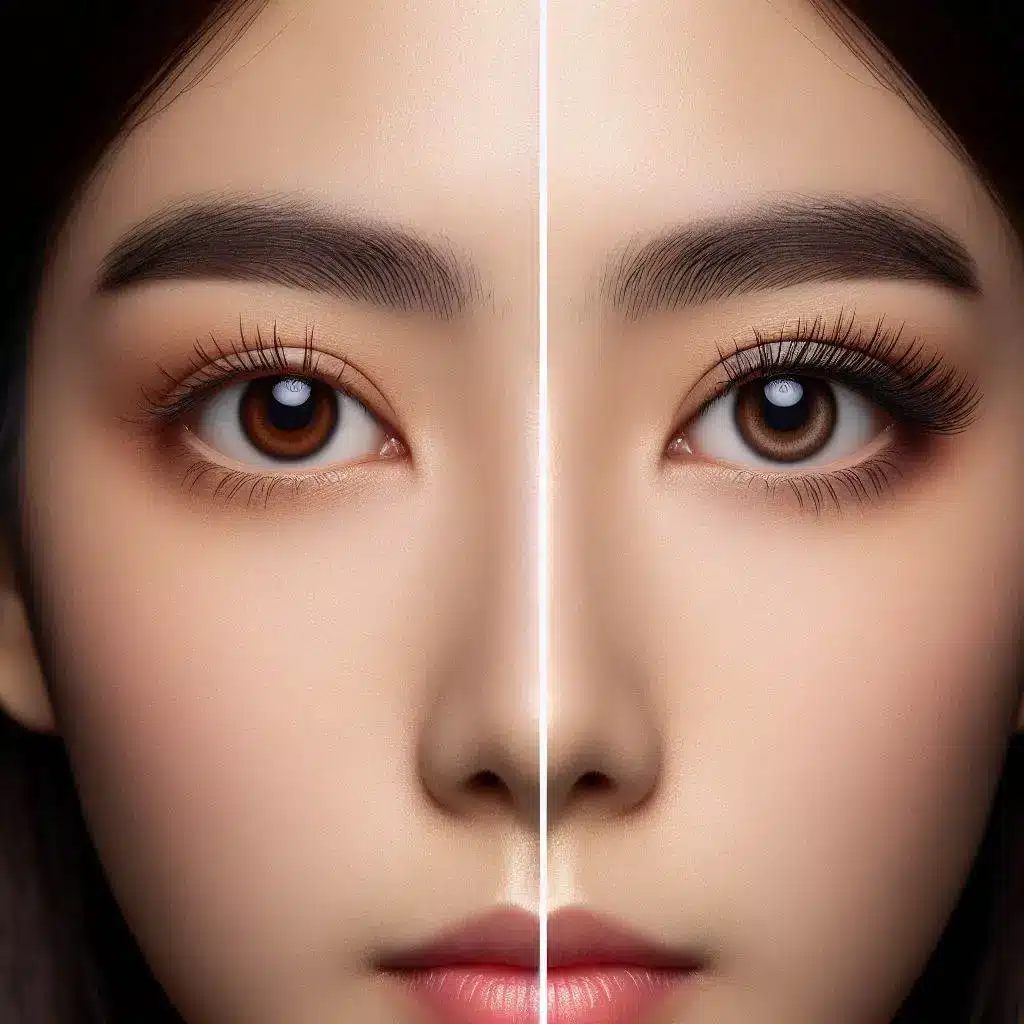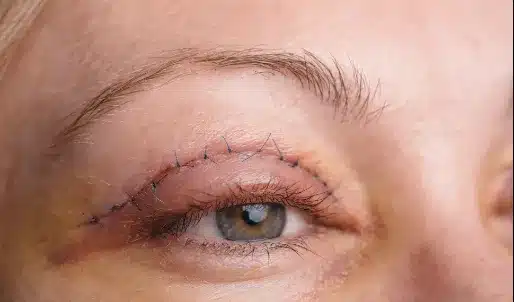Lower eyelid surgery, often referred to as lower eyelid blepharoplasty, is a crucial procedure within the realm of oculoplastic surgery, with institutions like the Bascom Palmer Eye Institute at the forefront of its advancement. Specializing in the delicate anatomy of the eye region, oculoplastic surgeons employ precise techniques to address aesthetic concerns and functional issues associated with the lower eyelids. With a focus on both cosmetic enhancement and functional improvement, lower eyelid surgery offers patients the opportunity to achieve rejuvenated and harmonious lower eyelid contours.
Different Types of Lower Eyelid Surgery
There are different approaches to lower eyelid surgery, each tailored to the specific needs and goals of the patient. The two primary types of lower eyelid surgery are:
- Transconjunctival Lower Blepharoplasty involves an incision inside the lower eyelid, known as the conjunctiva. This approach is ideal for patients who only require fat removal or repositioning. The advantage of this method is that it avoids visible external scarring.
- Sub ciliary Lower Blepharoplasty: In this approach, the incision is made just below the eyelashes, allowing the surgeon direct access to remove excess skin and fat and address muscle laxity. This technique is suitable for patients with significant skin sagging or excess tissue. Although it leaves a minor external scar, it is typically well-concealed and fades over time.
Clinic contact number: +989371200167
Tips about Lower Eyelid Surgery
Before undergoing lower eyelid surgery, consider the following tips to ensure a successful and satisfactory outcome:
- Consultation with a Qualified Surgeon: Schedule a consultation with a board-certified plastic surgeon specializing in facial procedures. Discuss your goals, expectations, and any concerns you may have. A skilled surgeon will provide personalized advice and guide you through the process.
- Preparation and Recovery Planning: Follow your surgeon’s instructions for pre-operative preparation and post-operative care. This may include avoiding certain medications, smoking cessation, and arranging for someone to drive you home after the surgery. Prepare your recovery area with supplies such as cold compresses and prescribed medications.
- Realistic Expectations: Understand the procedure’s limitations and have realistic expectations regarding the potential outcome. Lower eyelid surgery can significantly improve the appearance of the lower eyelids, but it cannot halt the natural aging process or address other facial concerns unrelated to the eyes.
- Healthy Lifestyle Choices: Prioritize your overall health and well-being before and after surgery. Maintaining a healthy diet, staying hydrated, and regular exercise can promote better healing and optimize the final results. Avoid excessive sun exposure and protect your eyes with sunglasses during recovery.
- Follow Post-Operative Instructions: Adhere strictly to your surgeon’s post-operative instructions. This includes taking prescribed medications, attending follow-up appointments, avoiding strenuous activities, and adequately caring for the surgical site.
Lower eyelid surgery, often referred to as lower eyelid blepharoplasty, is a crucial procedure within the realm of oculoplastic surgery, with institutions like the Bascom Palmer Eye Institute at the forefront of its advancement.
Benefits of Lower Eyelid Surgery
Lower eyelid surgery offers numerous benefits for individuals seeking to improve the appearance of their eyes:
- Reduction of Under-Eye Bags: Lower blepharoplasty can eliminate or minimize the appearance of under-eye bags, making the eyes appear tired and aged.
- Eliminating Puffiness: The procedure can effectively remove excess fat deposits and reduce puffiness, resulting in a more rejuvenated appearance.
- Smoothing of Wrinkles: Lower eyelid surgery can help smooth out fine lines and wrinkles around the lower eyelids, making the skin appear smoother and more youthful.
- Tightening of Sagging Skin: The surgery can address loose and sagging skin, restoring a firmer and more toned appearance to the lower eyelids.
- Improved Eye Contour: By removing excess tissue and reshaping the lower eyelids, the procedure can enhance the natural contour of the eyes, creating a more aesthetically pleasing appearance.
- Enhanced Facial Harmony: Lower blepharoplasty can bring balance and harmony to the overall facial features, complementing other facial structures and enhancing facial symmetry.
- Boost in Self-Confidence: Achieving a more youthful and rejuvenated appearance can significantly boost self-confidence and improve the overall quality of life.
- Long-lasting Results: While the natural aging process continues, the results of lower eyelid surgery are long-lasting, and the improvements achieved can be enjoyed for many years.
- Minimal Scarring: With proper surgical techniques, incisions are typically well-concealed, resulting in minimal visible scarring that fades over time.
- Versatile and Customizable: Lower eyelid surgery is a versatile procedure that can be customized to address each patient’s unique concerns and desired outcome, ensuring personalized and tailored results.

Side Effects of Lower Eyelid Surgery
Lower eyelid surgery, or blepharoplasty, can lead to several common side effects during the recovery period. While these effects are typically temporary and manageable, it’s important to be aware of potential issues. Here are specific side effects associated with lower eyelid surgery:
Occasionally referred to as a forehead lift, a brow lift finds its place in the spectrum of Brow Lift or Eyelid Surgery. This procedure emphasizes elevating the position of the eyebrows and smoothening the forehead region. Its main allure is its potential to mitigate wrinkles, furrows, and sagging skin significantly, symptoms often associated with aging or excessive stress. Understanding the primary goal of a brow lift is crucial for those at the crossroads of deciding between these two surgeries.
Swelling and Bruising
Description
Mild to moderate swelling and bruising around the eyes are common after surgery.
Clinic contact number: +989371200167
Duration
Swelling and bruising may persist for several days to weeks but gradually improve with time and proper care.
Discomfort or Pain
Description
Patients may experience mild discomfort, tightness, or soreness around the eyes.
Management
Pain medications prescribed by the surgeon can help alleviate discomfort during the initial recovery phase.
Dry Eyes or Irritation
Description
Temporary dryness, itching, or irritation of the eyes may occur post-surgery.
Treatment
Lubricating eye drops or ointments can provide relief and promote eye comfort.
Blurred Vision
Description
Blurry vision or difficulty focusing may be experienced due to swelling or changes in tear production.
Resolution
Vision typically returns to normal as swelling subsides and healing progresses.
Scarring
Description
While efforts are made to minimize visible scarring, some patients may develop temporary redness or noticeable scars along the lower eyelid incision sites.
Scar Management
Scars generally fade over time and can be further improved with scar treatment options if necessary.
It is crucial to discuss potential risks and side effects with your surgeon during the consultation to ensure you are fully informed and prepared for the procedure.

While results to vary, you should expect to see an improvement in the under-eye bags and a smoother transition between the eyelids and the cheeks after cosmetic lower eyelid blepharoplasty. Oculofacial Arts.
Best Candidates for Lower Eyelid Surgery
Lower eyelid surgery may be suitable for individuals who:
- Have under-eye bags, puffiness, or sagging skin.
- Desire to improve the appearance of their lower eyelids.
- Are in good overall health and have realistic expectations.
- Have no underlying eye conditions or infections.
- Are non-smokers willing to quit smoking before and after the procedure?
- Are committed to following pre-and post-operative care instructions.
During the consultation, your surgeon will evaluate your specific concerns, medical history, and overall suitability for the procedure.
Step-by-Step Process of Lower Eyelid Surgery
Lower eyelid surgery, or lower blepharoplasty, is a highly effective procedure for rejuvenating the appearance of the lower eyelids. This surgery can enhance the eyes’ natural beauty and provide a more youthful and refreshed look by addressing under-eye bags, puffiness, sagging skin, and wrinkles. It is essential to consult with a qualified plastic surgeon, follow pre-and post-operative instructions diligently, and maintain realistic expectations for the best possible outcome. While the exact steps of lower eyelid surgery may vary depending on the individual case, the general procedure involves the following steps:
- Anesthesia: Local anesthesia with sedation or general anesthesia is administered to ensure a comfortable and pain-free experience during the procedure.
- Incision Placement: Depending on the chosen technique, a small incision is made inside the lower eyelid (transconjunctival) or just below the eyelashes (subsidiary).
- Tissue Adjustment: Excess fat is removed or repositioned to reduce under-eye bags and puffiness. Depending on the patient’s needs, excess skin and muscle may also be trimmed or tightened.
- Incision Closure: The incisions are meticulously closed with sutures or surgical adhesive. In the case of transconjunctival incisions, no external sutures are required.
- Recovery and Follow-up: Cold compresses and ointments are applied to the treated area to aid in healing and minimize swelling. Your surgeon will provide detailed post-operative instructions, and follow-up appointments will be scheduled to monitor the healing process.
Advancements in Lower Eyelid Surgery
Lower eyelid surgery, a pivotal procedure in oculoplastic surgery, has garnered significant attention from renowned institutions and experts in the field. Institutions like Bascom Palmer Eye Institute at the University of Miami and the Wilmer Eye Institute at Johns Hopkins University have been instrumental in advancing the understanding and techniques of lower eyelid surgery. Experts such as Dr. Mark A. Codner and Dr. Bobby S. Korn have contributed extensively to the refinement of surgical approaches and patient care protocols, shaping the landscape of modern lower eyelid surgery practice.
Among the most active entities in lower eyelid surgery is the Mayo Clinic, recognized for its comprehensive approach to oculoplastic surgery and exceptional patient outcomes. Recent statistics indicate a steady increase in the demand for lower eyelid surgeries, with a notable emphasis on procedures such as lower eyelid blepharoplasty and lower eyelid retraction repair. This surge in demand underscores the growing recognition of the procedure’s effectiveness in addressing aesthetic concerns and functional issues related to lower eyelid anatomy. With advancements in surgical techniques and instrumentation, patients can now benefit from enhanced safety and precision in lower eyelid surgery, ensuring optimal aesthetic outcomes and patient satisfaction.
Clinic contact number: +989371200167
Summary
In conclusion, lower eyelid surgery, including lower eyelid blepharoplasty, remains a cornerstone of oculoplastic surgery, with a dedicated focus on addressing both aesthetic concerns and functional issues related to the delicate anatomy of the eyelids. Through meticulous surgical techniques and adherence to patient care protocols, oculoplastic surgeons strive to achieve optimal outcomes while preserving the integrity and function of the eyelid anatomy. As advancements in surgical techniques continue to evolve, patients can expect enhanced safety, precision, and aesthetic results in lower eyelid surgery, reaffirming its significance in the field of oculoplastic surgery and eyelid rejuvenation.
Fun fact: Did you know that blepharoplasty, commonly known as lower eyelid surgery, isn’t just about eyelid rejuvenation?
It’s a multifaceted procedure that addresses those pesky dark circles and annoying eye bags that make us look perpetually tired. Many are turning to this surgery to combat aging signs and achieve a fresher; more youthful appearance as facial aesthetics evolve. Talk about turning back the clock with a blink!
FAQs
- Is lower eyelid surgery painful? Lower eyelid surgery is performed under anesthesia, ensuring a comfortable experience. Some discomfort may be experienced during recovery, but it can be managed with medications.
- How long is the recovery time for lower eyelid surgery? Recovery time varies but generally takes 1-2 weeks. Swelling and bruising will subside, and normal activities can be resumed within a few weeks.
- How is lower eyelid surgery performed? The surgical technique varies based on the specific concerns. Typically, incisions are made either inside the lower eyelid (transconjunctival approach) or along the lower lash line (external approach) to remove or reposition excess fat and tighten skin.
- Is lower eyelid surgery safe? When performed by a qualified plastic surgeon experienced in eyelid surgery, lower eyelid surgery is generally safe. However, all surgical procedures carry some risks, which will be discussed during the consultation.
- What is the recovery like after lower eyelid surgery? Recovery from lower eyelid surgery involves temporary bruising, swelling, and mild discomfort. Patients are advised to follow post-operative instructions, including using cold compresses and avoiding strenuous activities during the initial healing phase.
oculofacialarts.com




